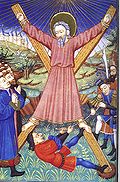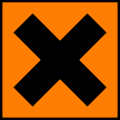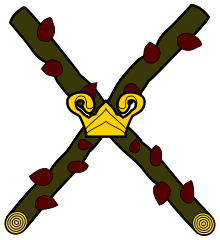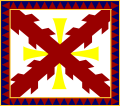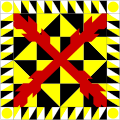St. Andrew's Cross
The St. Andrew's cross ( Latin crux decussata , 'cross in X-shape' or 'cross in the form of a Roman ten ', from Latin decussare 'in the shape of an X', 'cross-wise') is a cross with two diagonally crossing bars . It is also called the cross section after the holding device . If the cross of slanting beams (even of different lengths), the term is saltire used. This cross is often found at railroad crossings.
The name refers to the apostle Andrew , who is said to have died as a martyr on such a cross , as reports from the 4th century suggest. The diagonal cross has therefore become an attribute of this apostle and found expression in religion and especially in late medieval Christian iconography . Originally a symbol of the crossed woods of the fire sacrifice altar , it can also be found in depictions of the sacrifice of Isaac . It also contains the Greek letter Chi (Χ) as a symbol for Christ, for example in the Christ monogram . Especially in early Christian times, the St. Andrew's cross was often used for the name of Christ z. B. used as a distinguishing mark.
Picture gallery
St. Andrew's cross as a distinguishing mark of the Albertustaler
Half-timbered construction: St. Andrew's cross in the framework .
National and political symbol: Carlist cross .
National and political symbol: the flag of Scotland .
National and political symbol together with other corresponding symbols ( St. Patrick's Cross , George Cross ) integrated into one flag: Union Jack .
Andrew's Cross (as St Patrick's Cross) in the flag of Jersey
St. Andrew's Cross on the badge of the Russian Liberation Army
Saltire in the flag of the Russian Navy
Bulgarian Air Force 1938–1944
Andrew's cross in the icurriña , the Basque flag
Saltire in the war flags of the Confederate States of America
Andrew's crosses in the flag of Amsterdam
St. Andrew's Cross in the flag of Tenerife
Saltire in the flag of Nova Scotia
City of Rio de Janeiro
Fortaleza city
A yellow X on a house wall in Wendland as a symbol of the anti-nuclear movement
Half-timbered construction
The St. Andrew's cross is one of the basic principles in half-timbered constructions : In constructions made up of individual rods with articulated connections, rectangular shapes must be stiffened by inclined rods so that they cannot deform. If the stiffening components can only absorb tensile forces (e.g. steel cables) or only compressive forces (e.g. traditionally connected wooden beams), then all horizontal forces in the plane of the element can be absorbed by a stiffening in the form of the St.
In the framework of a half-timbered house , the St. Andrew's Cross is also a decorative form that is only required secondary or not at all to brace the building. It is often located in parapet compartments below the windows on the upper floors and was also executed with curly beams, then it is also known as a fire ram . Mainly in half-timbered houses of the 19th century, storey- high compartments with St. Andrew's crosses were made in a high, elongated form.
St. Andrew's crosses are also used to identify the so-called list of timber ( carpenter's mark ) in half-timbered buildings. Here they are common as the number ten of the Roman number system.
Danger symbol
In chemistry, St. Andrew's Cross symbolized until the changeover to the GHS the danger symbol for irritant (Xi) or harmful (Xn) substances.
In mining, Andrew's crosses indicate the dangers posed by old men .
In Wendland, and recently also beyond, a yellow St. Andrew's cross became a symbol of the anti-nuclear movement. Often the crosses, some several meters high, are visible from afar (see picture gallery).
On the island of Fehmarn, blue St. Andrew's crosses - modeled on the yellow anti-nuclear crosses - are used to demonstrate against the planned tunnel between Fehmarn and Denmark and the associated interventions in nature and the supposed negative effects on tourism.
Flags and coats of arms
In heraldry, the St. Andrew's cross is also called Schragen or Schragen cross . The common figures, which are arranged crosswise , then lie at an angle (also at an angle ) or crossed at an angle . The cross can also appear as a herald image in the coat of arms and follows the possible representation of crosses . An older heraldic expression is Schildzehner based on the Roman ten (X), which reflects the shape of the St. Andrew's cross. The heraldist uses the French term flanchis in a narrow and smaller version , for example in the Amsterdam coat of arms .
Other prominent uses:
- The cross is a national symbol in the flag of Scotland and as this is also included in the British national flag .
- In addition, as a traditional Orthodox symbol , the St. Andrew's Cross has become part of the (also blue and white) imperial flag of Russia .
Burgundy cross
One variation is the so-called Burgundian St. Andrew's Cross. It is also common in heraldry as a Burgundy cross. This is a more or less stylized representation of two crossed, only roughly cut branches. The red St. Andrew's Cross (also known as Cruz de Borgoña in Spain ) became the Spanish war flag in this form under Philip the Fair in 1506 after his marriage to Queen Joanna of Castile and remained so until 1843. To this day it is the symbol of the Carlist movement and part of the coat of arms of King Juan Carlos I of Spain.
 Flag of Tercios Morados Viejos .
Flag of Tercios Morados Viejos .
Flag of Tercios Morados Viejos ( 1670 ).
 Spanish merchant flag, abolished in 1762 .
Spanish merchant flag, abolished in 1762 .
 Spanish trade flag, used in Flanders .
Spanish trade flag, used in Flanders .
 Flag of Tercio de Ambrogio Spinola before 1621 .
Flag of Tercio de Ambrogio Spinola before 1621 .
 Flag of Tercio de Alburquerque .
Flag of Tercio de Alburquerque .
Flag of Florida (USA).
Flag of Alabama (USA).
Fuenterrabía u Hondarribia , Spain .
Coins

The St. Andrew's cross appears in the so-called St. Andrew's coins together with the image of the Apostle Andrew on coins from Brabant, Braunschweig, Hohnstein, Russia, Scotland, etc. Andrew coins were gold guilders , which are Brabant gold guilders minted from 1467 to 1489. The first Andreas talers are Hohnsteinsche from 1535 from the silver of the Andreasgrube in the Harz. From 1594 the dukes of Lüneburg and the electors of Hanover minted Andreastaler until 1773. Since Peter I there are Russian Andreas ducats to two rubles . The Cromwelltaler comes from the short time of the English Republic and also shows the St. Andrew's Cross of the Republic of Scotland on the reverse.
The St. Andrew's cross is also used as a mint master's mark . For example, coins from the Saxon mints of Schneeberg and Zwickau bear the mint master's mark, St. Andrew's Cross. These are the mintmaster marks of the mint masters Andreas and Sebastian Funke from 1501 to 1535. In the Zwickau Mint, the St. Andrew's Cross was used as a mintmaster mark by Sebastian Funke only from 1530 to 1533.
Traffic signs
Germany
The St. Andrew's cross is used as a road sign or as a symbol on road signs, namely:
- as a warning cross or regulation sign (sign 201 of the StVO ) immediately in front of level crossings with the meaning: "Give priority to rail traffic",
- as a symbol on the no-stopping sign (sign 283 of the StVO) with the meaning: "(absolute) no stopping on the lane"

- as a symbol on the hazard sign (sign 102 of the StVO) with the meaning: " Crossing or confluence with right of way from the right"

- Various German St. Andrew's crosses
Sign 201-50 of the StVO (without electrical overhead line )
The normal St. Andrew's cross consists of two crossed white bars with red ends. It was introduced in Germany in 1928/1929. A lightning arrow in the middle indicates that the railway line has an electrical overhead line . Possibly. indicates an additional sign with a black arrow that the St. Andrew's cross is only valid for road traffic in the direction of this arrow. In port and industrial areas, an additional sign with the words “Port area, rail vehicles have priority” or “Industrial area, rail vehicles have priority” can be attached. Two St. Andrew's crosses stand on top of each other in front of multi-track level crossings.
Rail vehicles have priority at level crossings with St. Andrew's cross; road traffic may only approach the level crossing at moderate speed. Road vehicles have to wait in front of the St. Andrew's Cross, if
- a rail vehicle is approaching,
- red flashing light or yellow or red light signals are given,
- the barriers are lowering or closed,
- a railway employee requests a stop or
- an audible signal, such as a whistle signal from the approaching train, sounds.
Stopping up to 10 m in front of the St. Andrew's Cross is not permitted if it is covered by it. Before and behind the St. Andrew's cross is within built-up areas up to 5 per m, outside built-up to 50 per m, the parking inadmissible .
There are currently the following variants in Germany:
- Sign 201-50: 1 St. Andrew's cross upright without lightning
- Signs 201-52: 1 St. Andrew's cross lying without lightning
- Signs 201-51: 1 St. Andrew's cross upright with lightning
- Sign 201-53: 1 St. Andrew's cross lying with lightning
In addition, two different flashing systems from before 1990 are still in use on the soil of the former GDR and the Bonn Republic.
Austria
Extract from the picture table of the traffic signs in Austria
Waymarks
The St. Andrew's Cross has been used throughout Germany as a signpost to mark supra-regional hiking trails and main hiking routes since the beginning of the 20th century . The Hagen engineer Robert Kolb came up with this symbol to mark hiking trails .
BDSM scene
In the BDSM scene it is used as part of bondage and SM practices.
The cross, which is up to approx. 2.40 m high, is made of wood or metal and has eyelets or hooks at the ends of the bars to fix arms and legs using ropes , chains , handcuffs or the like. Some of the constructions can be dismantled for easier transport or to save space, and they are often upholstered with leather or synthetic leather. St. Andrew's crosses are often attached to walls in the BDSM area, but there are also designs that can be set up freely in the room.
See also
- X (disambiguation)
- Cross , the character
Web links
- Burgundy Cross Flag 1506-1785 (Spain) ( Memento from December 8, 2009 in the Internet Archive ) The Burgundian St. Andrew's Cross (English)
- The St. Andrew's cross as a traffic sign
Individual evidence
- ↑ Karl Ernst Georges, Comprehensive Latin-German Concise Dictionary , Volume 2, Column 1937.
- ^ Meyers Großes Konversations-Lexikon 1905 - term St. Andrew's Cross.
- ↑ Gerd Heinz-Mohr: Lexicon of symbols. Images and signs of Christian art , p. 177. Eugen Diederichs Verlag, Munich, Neuausg. 1998, ISBN 3-424-01420-6 .
- ↑ Brockhaus Enzyklopädie, 19th ed. 1987, Vol. 1, p. 559, Vol. 4, p. 562; Encyclopedia Britannica, 15th ed. 1993, vol. 1, p. 391.
- ↑ Book of tables for the building and wood industry, Fachbuchverlag GmbH Leipzig, 1951.
- ↑ http://beltretter.de .
- ↑ Heinz Fengler, Gerd Gierow, Willy Unger: transpress lexicon Numismatics , Berlin 1976th
- ↑ Deutsche Reichsbahngesellschaft (Ed.): Official Gazette of the Reichsbahndirektion in Mainz of January 19, 1929, No. 3, Announcement No. 46, p. 18.

